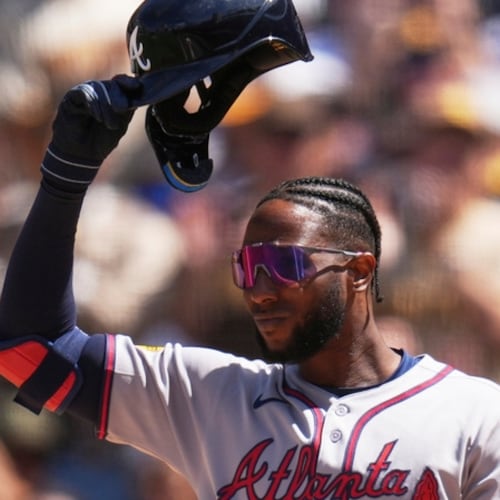Tom Glavine didn’t choose the number, the number chose him.
When he arrived at his first major league spring training, way back when the Braves sunned themselves in West Palm Beach, he was handed a uniform with 47 on the back. He had always worn 15 growing up, but who was he to ask for any special tailoring? He was an off-the-rack guy, all the way.
“I was just happy it wasn’t the other way around, happy it wasn’t a 74,” he joked. In general, the highest numbers are reserved for the dimmest prospects.
At maybe 6 feet tall, around 180 pounds, he was a fine athlete but certainly not imposing. He didn’t set any radar guns ablaze. In his first full season, with the 106-loss Braves of 1988, 17 of those losses appeared on his account.
“After that first year, I was not thinking about having my number retired or winning 300 games. I was just wondering how much longer it was going to last,” he said.
It lasted in the neighborhood of forever, 22 seasons and 305 wins. Glavine, now 44 years old and a year removed from his last outing, became a point man in the Braves slog from worst to first. He was the base of the team’s pitching trinity of the 1990s, the founding partner in the firm of Glavine, Maddux & Smoltz. His was the franchise’s single most important pitching performance, eight innings of one-hit ball to clinch the 1995 World Series. And his was a fascinating affair with the people of Atlanta, a relationship that proved no amount of intelligence or good work can save a player from scorn.
When the playing finally was done, Glavine had made No. 47 his own, had transformed an orphan numeral into a symbol for a man’s determination and a franchise’s rise to glory. On Friday, in a pre-game ceremony, No. 47 gets retired to the Turner Field rafters, out of reach of any future Brave.
Glavine finds it difficult to try to anticipate what the emotions will be on the night his number’s retired. “I know there is going to be a tremendous sense of pride, and some feelings of disbelief.
“I don’t really know how you can know how to feel, experiencing something that you never in your wildest dreams thought you would experience.”
Healing some wounds
As he stands on the field Friday, while the tributes flow, there will be myriad themes at play.
He said he hasn’t looked at the ceremony as any kind of fence-mending exercise. But there will be an element of that. The night is a good excuse to also retire the last of old animosities.
A loyal union man during the baseball strike of 1994, Glavine played an out-front role in that season-killing ordeal. In 2003, he signed with the division rival New York Mets. The combination proved too much for those fans who booed him heartily whenever he returned to Atlanta with the Mets.
“I’m sure I haven’t won everybody back. But for the most part, people, the greater majority of people in Atlanta, either like me or appreciate what I did as an Atlanta Brave. That’s the best you can hope for, that a majority of people appreciate who you are and what you do,” Glavine said.
There were raw feelings between player and management as well. Glavine and the Braves went through two difficult divorces: the signing with New York; then, after a comeback season with the Braves was cut short in 2008 by shoulder surgery, Glavine suddenly was axed by the team early in 2009.
“That’s part of the circle of life in baseball more often than not,” Braves President John Schuerholz said. “Sometimes those partings are painful and hurtful and tough not only for the player but for the organization and the fans.”
As recently as June 2009, after a rehab outing in Rome had failed to convince the Braves to keep him, Glavine was informing Atlanta radio listeners that he had been “misled and mistreated” by the team. The Braves had instead opted to go with rookie Tommy Hanson, a move few argued against.
By the end of the season, Glavine said many of the wounds had scabbed over.
He figured his career “would be over by then anyway and it was kind of useless to carry this baggage around, harbor these feelings that I had. At that point, John and I were able to talk and we were able to hash some things out.”
Guile worth 300 wins
Glavine was returned to the fold in the nebulous role of assistant to the team president, as well as occasional (13 games this season) broadcaster. Friday night completes the reintegration of a player to his home.
Aside from its healing properties, the ceremony also recognizes a pitching career built upon grit and subtlety over power.
John Smoltz had the blistering fastball and the biting slider. Glavine had the change-up, ownership of the fringes of the plate and the stubbornness never to offer up a pitch on the hitter’s terms.
“Nothing he did caught your eye, but the outcome always caught your eye,” Smoltz said.
He won 20 games in 1992 while pitching much of the season with cracked ribs.
That October night in ’95, when he shut down the Indians and Atlanta gained its one and only major championship, “epitomizes how he pitched, who he was,” Schuerholz said. “You want somebody with toughness, reliability, determination, and Tommy had all that. And he showed it that game.”
Guile is not easily documented. There are 24 300-game winners in major league history. Glavine is among only three who never struck out 200 or more in any season.
“If winning 300 games was just about stuff, there’d be a whole lot more 300-game winners,” he said.
More than the win total or even the decisive World Series performance, it was his role as a bridge to the championship run of the 1990s that most gladdens Glavine. “It was really remarkable in such a short period of time to go from somewhat of a laughing stock to a team that people envied and wanted to emulate. I’m most proud of having a part in rebuilding the organization,” he said.
Looking back will be easy. Looking ahead is a little trickier. Glavine is at an odd stage in life, finding himself in that DMZ between life as a player and whatever comes next. A year ago, he and his wife Chris adopted a newborn baby boy, adding a fifth child to the fold. Spending time with his brood is the priority of the moment.
“I’m battling that exercise of juggling my life as a continuing professional versus my life as a parent and a husband. You go through the stage where you want to be home, you don’t want to miss anything and that’s where I’m at right now,” he said.
He is unable to predict what he’s going to be when he grows up.
Like that long-ago spring in Florida, he’ll have to take what’s handed him and make the best of it, all the while celebrating the best parts and putting aside the dregs.
The Glavine file
Born: March 25, 1966, Concord, Mass.
Drafted: Braves second round, 1984. Los Angeles Kings (NHL) fourth round, 1984.
Key career stats: 305-203; 3.54 ERA; 4,413.1 innings pitched; 2,607 strikeouts; 1,500 walks.
Memorable moments:
● Won Cy Young Award in 1991 and 1998, finished in the top three in voting four other seasons.
● Won clinching game of 1995 World Series vs. Cleveland, yielding only one hit over eight innings. Was World Series MVP.
● Won 20 or more games in a season five times.
● Won 300th game as New York Met, Aug. 5, 2007, at Chicago.
Forgettable moments:
● Gave up record seven straight hits – nine total over 1 2/3 innings – as starter in 1992 All Star game.
● Lost final two postseason starts with Atlanta, in 2002 Division Series loss to San Francisco. Finished series 0-2 with 15.26 ERA
● Lost final appearance with Mets in 2007, giving up seven runs in first inning in a game that eliminated team from postseason contention.
Here’s to symmetry: He was 2-4 with a 5.54 ERA during his first, partial major league season, 1987. He was 2-4 with a 5.54 ERA when his career ended due to surgery in 2008.
About the Author
Keep Reading
The Latest
Featured



